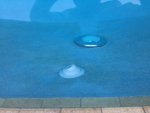Hello -
I have a stain on the plaster walls of my pool that extend about 2.5 feet underwater from surface and then stops; there is a visible horizontal line around pool at that depth, below which there is no stain (see attached picture). I'm not sure whether this is a metal-type stain or an algae stain. I'm looking for guidance as to the best way to diagnose and treat.
Background: Earlier this summer, I went on vacation for a couple of weeks and had a green algae issue when I returned. I followed instruction on this site to resolve the issue, which I think it is now under control (no re-emergence for ~1 month). I first noticed this 2.5 ft deep wall stain after having resolved the algae issue, but I'm not sure if it is related or I only noticed because I was now paying more attention. Perhaps unfortunately(?), I also used Regal Algaezone Plus (which contains copper) during my battle with the algae. Based on tests I was getting at the pool store during that time copper levels did come up a little but have since gone away (perhaps the copper attached to my wall).
Quick test: As I was adding muratic acid tonight to lower pH, I decided to run a quick test. I poured a little acid close to the wall (more quickly than I usually would) and scrubbed the plaster near surface with a brush. This definitely removed the stain in that location, but it was a locally high concentration of acid. Normal brushing does nothing to remove the stain.
Current Levels:
FC - 3
CC - 0-0.5
pH - 8 (before my acid addition above, but my pool typically runs this high; no matter how much acid I add, within a week it has increased to this level again)
TA - 80-90
CH - 275
CYA - 50
Thanks in advance for your advice.

I have a stain on the plaster walls of my pool that extend about 2.5 feet underwater from surface and then stops; there is a visible horizontal line around pool at that depth, below which there is no stain (see attached picture). I'm not sure whether this is a metal-type stain or an algae stain. I'm looking for guidance as to the best way to diagnose and treat.
Background: Earlier this summer, I went on vacation for a couple of weeks and had a green algae issue when I returned. I followed instruction on this site to resolve the issue, which I think it is now under control (no re-emergence for ~1 month). I first noticed this 2.5 ft deep wall stain after having resolved the algae issue, but I'm not sure if it is related or I only noticed because I was now paying more attention. Perhaps unfortunately(?), I also used Regal Algaezone Plus (which contains copper) during my battle with the algae. Based on tests I was getting at the pool store during that time copper levels did come up a little but have since gone away (perhaps the copper attached to my wall).
Quick test: As I was adding muratic acid tonight to lower pH, I decided to run a quick test. I poured a little acid close to the wall (more quickly than I usually would) and scrubbed the plaster near surface with a brush. This definitely removed the stain in that location, but it was a locally high concentration of acid. Normal brushing does nothing to remove the stain.
Current Levels:
FC - 3
CC - 0-0.5
pH - 8 (before my acid addition above, but my pool typically runs this high; no matter how much acid I add, within a week it has increased to this level again)
TA - 80-90
CH - 275
CYA - 50
Thanks in advance for your advice.



